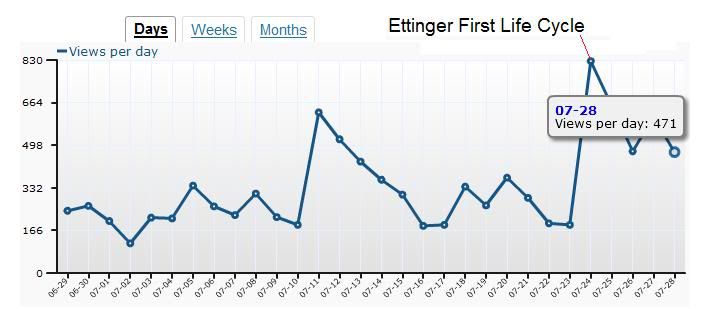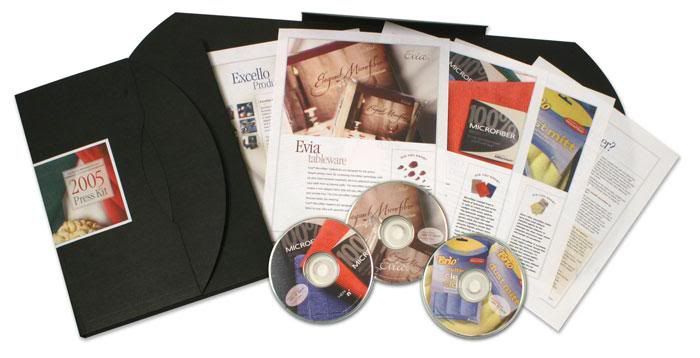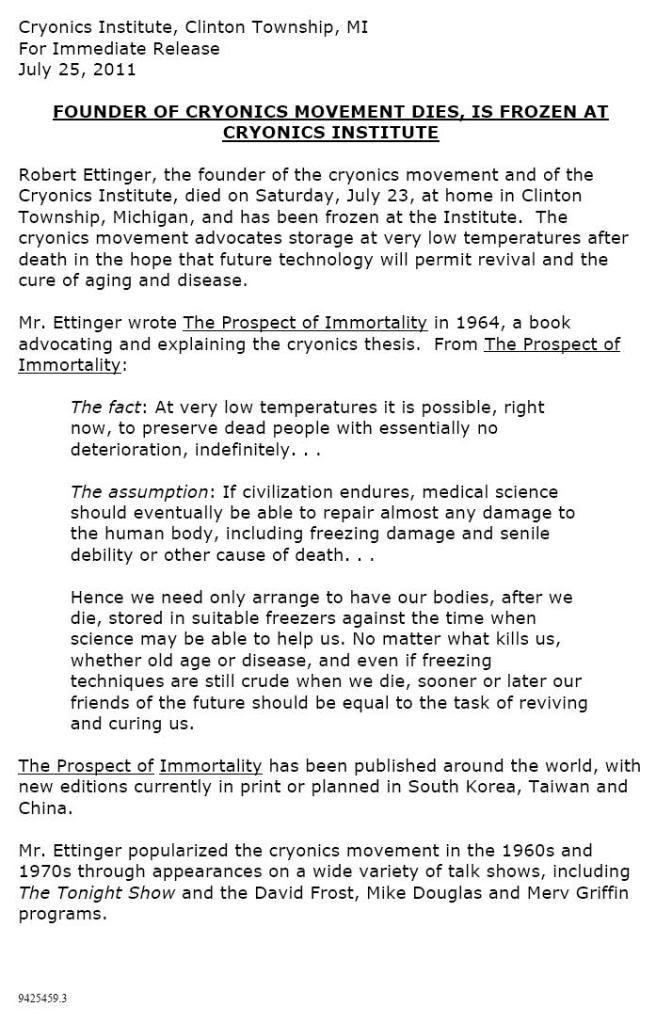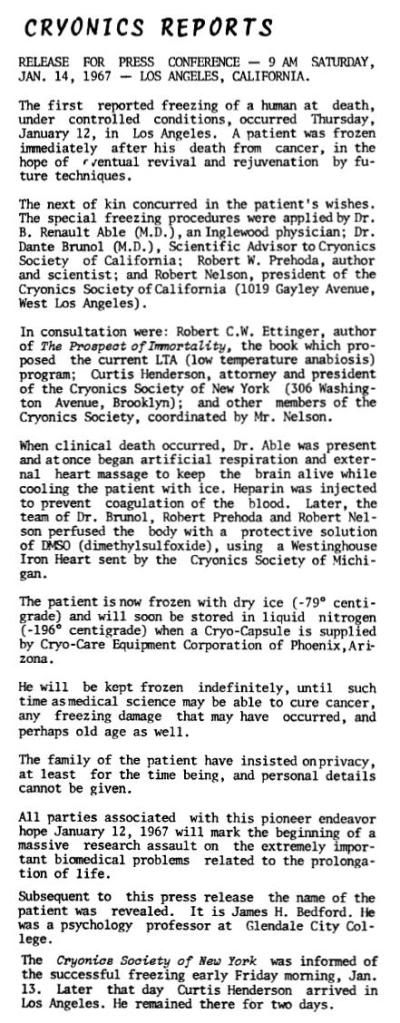
Figure 1: Chronosphere performance data from 29 June through 28 Jul, 2011. The large bump up in views on 07-29-2011 represents the effect of the posting of Robert Ettinger’s passing into cryopreservation and the impact from targeted mailings of a media kit to ~ 100 major media outlets around the world.
By Mike Darwin
Introduction
One of the most valuable things I learned from cryonics is just how long and how hard a business it is to build an organization. Or even to build a base of readers and subscribers if you are in the business of producing a newsletter, a magazine, or yes, even a blog. Above are the stats for Chronosphere from 29 June through 28 July of this year (stats for the year to date are present in Figure 5, below).
I’m doing this update much sooner than I planned, because I wanted to show, objectively, the power of a single well planned and well timed intervention on “public” awareness and on readership. Public is in quotes because it is misnomer; the people who’ve come here and who will stay here as readers are a unique and highly distilled fraction of the public. Aside from the fact that they can read, and do so at a high level, they know how to use the web and they are at least intellectually curious enough to have come to light here. Most importantly, some subset of these people are nascent or actual cryonicists/immortalists.
The Worst Press Release in Cryonics History?
It is common practice and prudent public relations management to have media kits prepared and ready to go for any unexpected contingency. A representative media kit is shown in Figure 2, below, and contains detailed information on every aspect of the organization’s operations and public programs, as well as resource information and the best examples of prior media coverage. Such a press kit will also have “supplied images” that the media can use, as well as documentary (and if available, interactive) CDs or DVDs which tell the organization’s story in a tight, coherent way. In the case of cryonics, at a minimum this would mean lay and technical white papers on the issues of cryo-injury and the repair of freezing or vitrification damage, detailed written and visual guides to how cryopreservation is carried out, scientific papers, scientists’ statements and other third-party data supporting the feasibility of cryonics, promotional literature, samples of any magazines or newsletters, and finally, a specific press release, as appropriate. It is also appropriate to have a separate, concise document that deals with common misconceptions and which provides a credible answer to basic and often asked questions, such as how much cryonics costs, who will revive cryonics patients, how will patients adjust to life after being displaced into the future by decades, or even centuries, and so on.

Figure 2: A typical media kit for a technology-oriented enterprise.
Such press kits were generated in cryonics as early as the late 1960s(obviously, minus CDs or DVDs) and Alcor at one time maintained an extensive press kit that was kept in stock at all times through till at least 1991. Below (Figure 3) is the press release sent out by the Cryonics Institute on 25 July, two days after Robert Ettinger’s cryopreservation began. It is an amazing document, starting with title, and it becomes even more surprising from there.

Figure 3: Press release from the Cryonics Institute (CI) announcing that the father of cryonics, Robert C. W. Ettinger was pronounced medico-legally dead on 23 July and cryopreserved by CI in Michigan.
The first thing we learn from the press release is that Robert Ettinger was frozen. Is this true? Was he vitrified-frozen or simply frozen? Was he cryoprotected or straight frozen? Depending upon the realities, this document either represents enormous hubris, or enormous ignorance, because whatever else happened to Bob Ettinger on 23 July, being dead was not on the menu – not yet, anyway – and some of the media headlines got that right! After over 20 years of effort to remove cryonics and cryonics patients from the realm of death and the dead, the father of the cryonics movement gets “frozen” after he is “dead,” and this happens not in 1967, but in 2011. Incredible!
Early on in the classic 1974 Mel Brooks film, “Young Frankenstein, ” as Dr. “Fronkensteen” is concluding a lecture to a group of medical students, an unctuous-obnoxious student hurls leading question after leading question at the good doctor, finally concluding with: “But as a Fronkensteen, aren’t you the least bit curious about it? Doesn’t bringing back to life what was once dead hold any intrigue to you?” That was too much. Young Frankenstein, yells out, “You are talking about the nonsensical ravings of a lunatic mind! Dead is dead!”
Of course, Dr. Fronkensteen is right, dead is dead, and everyone who isn’t a lunatic knows that. The dictionary definition of death is: “the end of life; the total and permanent cessation of all the vital functions of an organism.” That’s a good definition of death and it most certainly does not reflect the current state of Robert Ettinger.
The medical physicist and cryonics activist Dr. Brian Wowk was the first point this out in his 1988 essay, “The Death of Death in Cryonics,” I can also justifiably speak to this issue myself, since I am a peer-reviewed, medical journal published, ‘expert’ in this area, see the article “Pro-Con Ethics Debate: When is Dead Really Dead?” The use of this terminology by a cryonics organization, after so much reparative work and effort, is shocking. In fact, I would go so far as to say that the CI press release is a step back from the press release announcing Dr. Bedford’s cryopreservation, which was sent out on 14 January, 1967; 44 years ago (see Figure 4, below)!

Figure 4: The January, 1967 press release announcing the cryopreservation of Dr. James H. Bed-ford was more detailed, more hopeful and more informative by far than the CI press release announcing the cryopreservation of Robert Ettinger on 23 July, 2011.
To appreciate the degree of dysfunctionality in contemporary cryonics with regard to public relations, it is probably necessary to go back in time to 1990, when Dr. Thomas K. Donaldson unsuccessfully sued the Attorney General of the State of California for the right to an elective cryopreservation in order to prevent the destruction of his brain by a malignant brain tumor. Much of the media coverage surrounding the Donaldson lawsuit was neutral to slightly sympathetic. And a disproportionate amount of the “supposed” public reaction was sympathetic, or asked questions in a positively loaded way. This was the case because there was a coordinated letter writing effort. Not only did many Alcor members write letters themselves, many hundreds of hand written, typed and computer-typed (daisy wheel generated) letters also went out in packages from Alcor in Riverside, to re-mailers, who then re-posted them to local papers, TV stations, and the like, so that they would have local postmarks, and thus and local credibility. This is how it is done in the real world of public relations.
Whether you approve of that kind of approach in public relations is neither here nor there in the context of how cryonics is being publicly handled today. Things have gotten so bad that the cryonics organizations themselves don’t know whether their patient’s are dead, alive, in suspended animation, or in a fourth, and far less certain state called cryopreservation. That last state is the one the public most needs to be educated about, and it is ostensibly the job of the cryonics organizations to do it. This press release appears to have be written by David Ettinge, and one is tempted to shout out the question:
“But as an Ettinger, aren’t you the least bit curious about it? Doesn’t bringing back to life what was once dead pose any contradictions for you?”

Figure 5: The number of views Chronosphere receives per month has been increasing steadily since its launch, and will likely reach or exceed 10K per month, by the end of July, 2011.
I do not know what the traffic is like on the various cryonics organization websites, and my inquiries for this data have gone unanswered in the past. Judging from the average number of hits per month Chronosphere is now receiving, my guess would be that for Alcor and CI, that number is orders of magnitude greater.
We have a lot of work to do.

It looks to me as though there will always be a “2 tier” understanding of cryonics, as with any other specialty. Public understanding will use the semantic framing of the common man, which is being “frozen at death”. Insiders like us ought to become comfortable with that and simply change gears when speaking to one another using “vitrified at deanimation”. I see insider/outsider framing in many subject areas and consider it to be quite normal. We can work with it, don’t you think?
On the matter of your readership: As you might know, I’ve blogged and used forums for years and I have to say that your blog is actually quite top notch as far as the other online cryonics efforts out there. You’ve instilled a sense of your own personality in your reporting, much like Mark Plus does in his blog. DeWolf changed his blog radically recently– which indicates what he was doing must not have been working. The CI forums are all blocked, for members only. ColdFilter has become unused. Cryonet ceased operations. Even I quit! Alcor’s blog is too formal to be interesting. I would say your blog, here, is my #1 choice now as a cryonics watering hole given your background as well as your format and open comment section (without the need for signing in). That’s why I started posting here a bit with Ettinger’s cryocontinuation. Thanks for making the effort– I hope you keep it going. –RP.
At times I wonder if it is better to concede that cryonicists are “dead” while defending the notion that there can be a reversible form of death. Some people get resentful when you try to change their terminology for them. If they don’t get cryonics to begin with, the notion that Robert Ettinger is not dead is about as weird and foreign as aliens landing.
I guess I had an advantage in database class years ago when it was drilled into me that boolean logic could have three values: “true,” “false,” and “unknown.” Cryonics patients are all firmly in “unknown” for me, which is very comfortable for me and fits perfectly into my thinking. But a lot of people don’t do well with “unknown.”
The obvious conclusion to me is that force should be used to coerce everybody into taking database classes until they get it, but there may still be a flaw in my reasoning. :)
Things that Galileo fortunately did not say:
“At times I wonder if it is better to concede that that sun moves around the earth, while defending the notion that there is always the possibility that the earth revolves around the sun. Some people get resentful when you try to change their view of the cosmos. If they don’t have telescopes and cannot look and see for themselves, or they cannot do the calculations that show that the wandering stars must indeed move around the sun, then they will become angry. The notion that the earth revolves around the sun is about as weird and foreign as was the notion that the earth is a sphere, and not a plane.”
Good point Mike, but we’re debating terminology rather than fact aren’t we? Robert Ettinger’s legal status is dead. Doctors call him dead. Neither of those things means he can’t live again by any physical law.
I just say “legally dead” when I mean “legally dead.” I don’t feel like the idea of cryonics can get much traction with most people if you don’t start with the idea that “legally dead” doesn’t mean necessarily “dead” as a first principle. Everybody I know seems to grasp the fact that people who would have been “legally dead” a few years ago are now recognized to be revivable, in fact many people I know seem fascinated by that fact. I don’t think it’s really too big for them to move from there to the idea that “legally dead” is sometimes mistaken and that medical technology is gradually pushing back that frontier.
Sure Luke, I appreciate that, but semantics isn’t just quibbling over words, and in this case it is REALLY not about quibbling over words. I move in strange circles these days and I get to see and do some really unbelievable things. About 6 months ago, I had the chance to run an experiment on 7 people who were undergoing polygraph examination for employment. The examiner was kind enough to do a test for me at the end of formal session. This test consisted of having the subjects listen to a string of words whilst the examiner recorded their GSR, HR, and BP. The words were: duck, action, cart, plastic, child, death, working, driving, being, animal, dead, table, television, life, snake, ocean. Each word was enunciated clearly, the examiner paused till any reaction was complete, and then moved onto the next word. Two words in that series evoked anxiety-related changes in GSR in all 7 subjects, and BP and HR increases in 4 of the 7, one other word evoked GSR changes in 3 of the seven subjects and BP and HR changes in 2 of the three. Want to guess what the words were?
The negative response evoking words were dead, death and snake. My suspicion is that “freezing” doesn’t exactly make people feel all warm and fuzzy, either. So, as soon as you utter the words “freezing dead people” you have evoked a visceral and strongly negative reaction. If you have ever been in a conversation with someone who is also halfway listening on the phone and they are suddenly told by the caller that their kid was just hit and killed by a car, or that that their house just burned down, well, a mini-version of that is pretty much what happens when you say you freeze dead people. You just shot yourself in the foot and they will have instantly “turned off and tuned you out.” Those words are not only repulsive to many people, they don’t make sense to them and they evoke images of meat in the freezer – something you do to dead things you are going to eat. It’s awful.
In the 1970s the acute reaction was just terrible. I was at a party in a young architect’s swanky home on Twin Peaks, in SF in 1979, and he asked me what I was doing in SF. I told him: “Well, I freeze dead people and I just finished two back-to-back cases in LA and, since I was out here in California, well no way was I going to miss seeing San Francisco.” He excused himself immediately and went to the loo. He didn’t come back. Turns out, my remarks made him nauseated and he went to the loo and passed out. Since he was (unbeknownst to me) also a diabetic, his friends thought he might be in a diabetic coma. There was a huge to-do, and when it emerged that it was ME who was responsible, well, let’s just say the rest of the evening was very strained, and needless to say, the subject of cryonics did not come up again.
We can’t let their language derail us; no way, no how. What’s more, we are doing a public service to medicine and the community at large by educating people on the non-binary, “gray” nature of death. Critical care medicine is confronting this problem in a huge way, and what’s more, a lot of people are clued in to that fact. Are people in a persistent vegetative state (PVS) dead, or alive, or somewhere in between? Is it OK to take organs from a person whose heart has stopped (“irreversibly’) but who is not “brain dead”? People need to come to grips with these gray-state issues, because completely apart from cryonics, they are going to increasingly confront them in medicine and in the law.
And it is not hard to communicate action in the face of uncertainty – it’s easy to do by way of analogy. If someone buys a stock they are making a (hopefully) informed bet that it is going to increase in value. Until it does or doesn’t, nobody knows if their course of action was profitable, or not. HOWEVER, if that same person is buying a diversified portfolio of shares, then even if he loses on some stocks, it is possible to say that he is behaving rationally, prudently and in just about the only way you can if you want a high probability of return on your investment with a minimum of risk.
How bad do you want to get rich and what are your circumstances? If your biggest dream in life is to be a millionaire and you have an IQ of 80, and some days you find it confusing to tie your shoes, then the only way you can reasonably expect to be a millionaire is to buy a lottery ticket at least once in your lifetime. That’s not irrational, it is perfectly sane and reasonable, given that you REALLY want to be rich and you REALLY aren’t going to get that way by investing, or by hard work. We’re in the same position. Don’t try to “sell” cryonics to people. Instead, tell them the truth and let them make an informed decision. The best way to do that, at least for me, is to explain why and how much I love being alive and that from my perspective, dying destroys the most important thing to me, and it also will destroy the next most important things to me: my friends, my family, my culture and my civilization. THAT’S what makes cryonics worth pursuing and rational. Once you get that far, you can point out that the crappy odds are not set in stone. They can change based on the actions of individuals. No Wright Brothers = no flight for awhile longer, anyway. No Edison = no phonograph; and there was no phonograph for a long, long time, even though it is an easy bit of technology. WE CAN CHANGE THE ODDS. Yes, they are shitty right now. Yes, we may well not make it. However, we would be cowards and losers not to try, given how much we value our lives. If they don’t feel that way, well, that’s their loss.
So, yes, language matters. Please, use the proper words. — Mike Darwin
I’d like to also congratulate Mike on doing a great job with this blog. The (tasteful) nude photos he put up in another posting were certainly not a negative either. ;-)
I have quite a number of posts in queue dealing with practical “limited” or “incremental” rejuvenation technologies – things like dietary and pharmacological interventions for long-term weight-loss and weight control that work (which is rejuvenation if you are clinically obese), lifestyle and pharmacological techniques for slowing and reversing the effects of aging and depression on the brain, and of course, molecules that can restore libido and sexual performance (mostly in males) – at least temporarily. There will be lots of illustrations with the latter posts. And frankly, I could use some help there, because I am gay and I mostly don’t even see women. If you ask me to think of a woman I know casually, what will come to mind is a montage of impressions and thoughts that are either not visual, or only visual in as fragmented and usually negative way – maybe blue hair, or clown makeup. It takes me multiple exposures, or some deeper connection before I can even see a woman. This is not the case with men. I have the same problem with finding my way around – zero memory for landscape sequences. So, if there are any folks out there who want to vet my illustrations or illustrate the articles in some cases, let me know. Looking at straight porn is also not my idea of a good time – though it isn’t any worse than searching for other illustrations here.
Finally, the articles dealing with sex will use common, everyday language. Fuck is a perfectly acceptable word on the BBC after 2100 hours, and I intent to use it and other words like it – to pretty much the same standard as the British do in their HIV education materials:http://www.gmfa.org.uk/londonservices/booklets-and-postcards/pdfs/semen-sex-hiv.pdf, http://www.tht.org.uk/informationresources/publications/gaymengerneralinformation/bottomlinethe124.pdf. Semen Sex and HIV, the booklet at the first URL is produced by the Camden National Health Service. Imagine something like that being published by the US NIH!!?? — Mike Darwin
More on Jane Fonda for you, Mike:
http://www.dailymail.co.uk/tvshowbiz/article-2022304/Jane-Fonda-73-displays-age-defying-figure-sheer-dress.html
What a hoot! The boil-off rate inside the dewar holding Jerry Leaf must be up in the triple digits! He loathed her to an extent just short of homicide for her treasonous actions during the Vietnam war. Without a doubt that’s why she has remained on my radar these many years, and why when I saw a copy of her latest autobiography in the dustbin, I took it home and read it. After reading it, I think I figured out he second reason he hated her so much; she’s a castrating bitch. Ahh technology, medical and otherwise: if you want to Jane Fonda’s father, Henry, at the same age, you can do in this clip where he is presented the AFI Lifetime Achievement Award: http://www.clicker.com/web/american-film-institute/henry-fonda-accepts-the-afi-life-achievement-award-1778549/ — Mike Darwin